This is Part 1 of a 3-Part series of posts. Part 1 is here, and Part 2 is here.
At the penultimate session of the Three Rings 10th Birthday Conference, JTA presented a session entitled Where do we go from here?, taking a look at the lessons we’ve learned over the past decade, and some of our plans for the future.
This post covers the third part of that talk, announcing our plans for a massive shift in the way users interact with both their Three Rings accounts and with the organisations they volunteer for.
Three Rings Accounts:
Ever since the very first version of Three Rings, a user account has been part of an organisation. When a user logs in, they’re logging into their account at their organisation: as long as they keep their password secure only they can access it, but the account itself belongs to the organisation. You can’t log in to Three Rings if you aren’t volunteering with an organisation that’s using Three Rings.
That’s fairly logical, at least, but there are occasions when it creates trouble:
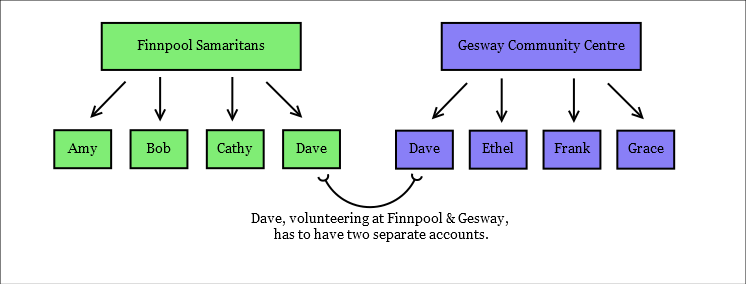
The above diagram shows one of the biggest problems of the current Three Rings account structure. Dave lives in Finnpool, where he volunteers as a Samaritan, but he catches a bus every day to go and work in neighbouring Gesway. After work, he volunteers with a youth club at Gesway Community Centre. Because user accounts belong to one single organisation, Dave has to have two separate accounts on Three Rings, with two unique usernames: one for each organisation he gives his time to.
And the problems don’t necessarily end there. Let’s imagine Cathy gets a new job in Gesway and, instead of commuting to work like Dave, sells her old house and moves to Gesway. She stops volunteering with Finnpool Samaritans, and instead joins Dave as a volunteer at the Community Centre. Right now, this is what has to happen:

The need to delete old accounts (and the need to create new accounts for people who actually had accounts on Three Rings before they moved organisation) is creating quite a lot of work for volunteers. What’s worse, is that it’s been creating that extra work since we started offering Three Rings to Samaritans branches back in 2009, and the workload is increasing as more and more organisations adopt Three Rings. We want to fix that.
A new account model
In addition to the other improvements we’re planning for Milestone: Krypton next spring, we want to make some changes to the way user accounts are structured. These changes will then pave the way for further developments, with one big change in the pipeline for the future: we want individual volunteers to own their own Three Rings accounts.
So, instead of logging in to your Three Rings account and seeing information for the organisation your account belongs to, you’ll be able to log into your Three Rings account and see any information that’s been shared with you by organisations to which you belong. That’s a big change, but it should make life easier for a lot of our users, both right now and in the future, as they develop their volunteering careers.
When we make this happen, all existing Three Rings accounts will remain associated with their current organisations. Organisations will still be able to create accounts, too. But a big difference will be that – as long as the user and the organisation agree – a user can link their account to more than one organisation.
Just look at what that would do for Dave, with his two accounts:
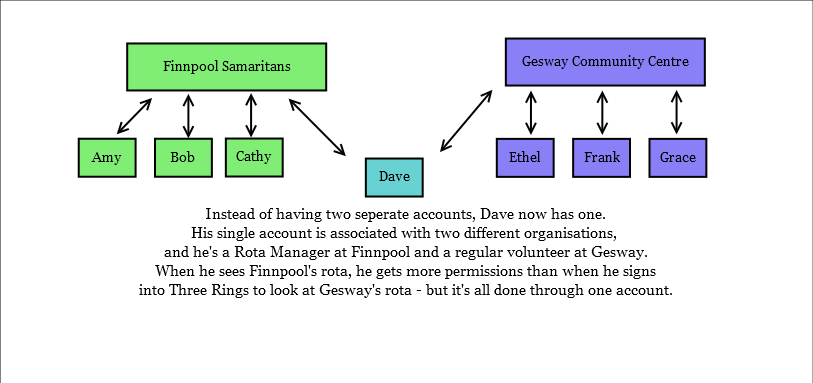
We’d ensure that the organisations retained control of each user’s permissions within their organisation – Dave wouldn’t have Rota Manage permissions at Gesway Community Centre, even though he has them at Finnpool Samaritans- and in the same way, Dave would be able to share some of his personal information, like his phone number, address or CRB status, with Gesway volunteers that he might not want to share with the Three Rings admins at Finnpool: in this new model, everyone would have more control over what data they share, and who they share it with.
This new system works well for Cathy, too:
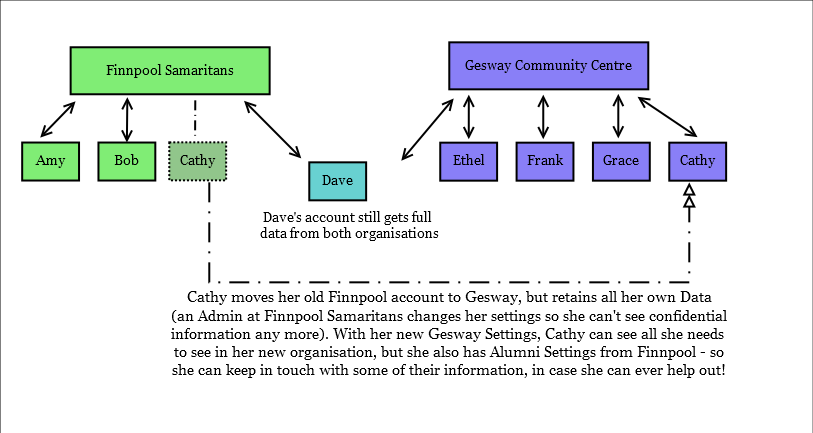
As the newer version of Cathy’s tale shows, the proposed new account structure would also save volunteers at the new organisation the trouble of creating a new Three Rings account and filling it with data for someone whose account already exists on the system.
If you’ve taken a close look at the above diagram you might also have noticed the note talking about ‘Alumni Settings’. That’s the second big change we’d like to make to the way accounts work.
Account Levels
Currently, Three Rings assigns volunteers permissions via the Roles system (and, to a certain – and sometimes confusing! – extent, through Experience Levels). We’d like to tidy that up and fold Experience Levels into Roles, because that better matches the way people are using (and expecting to use) the system these days. But we’d also like to introduce different account Levels.
That’s not some sneaky way of charging more, or of suggesting that a ‘Trainee’ account wouldn’t be cheaper than a ‘Volunteer’ account (we’re really not after your money, and we’re not introducing individual accounts just so we can charge you for them!). Instead, we want account Levels to better represent the different types of volunteer that already exist at organisations usingThree Rings.
Before we go any further, let’s take a quick look at how Roles & Experience Levels work right now:
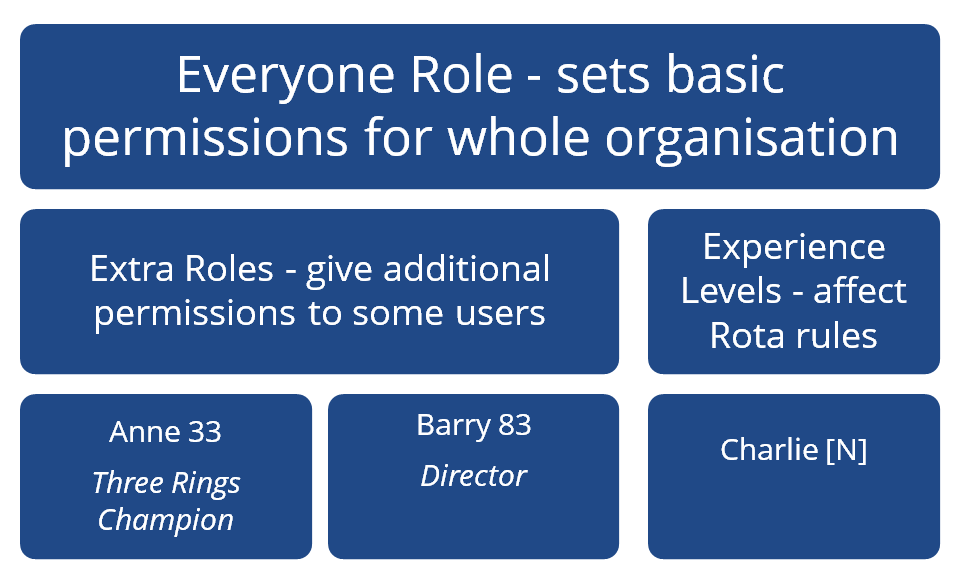
As you can see, Three Rings currently assigns permissions on a model founded on the assumption that each organisation has only one type of volunteer, reflected by the Everyone Role. Some of those volunteers then get given extra permissions based on their role, but nobody can have fewer permissions than the Everyone Role has.
That’s because Three Rings has historically focused on volunteers staffing a rota – what many of our organisations call ‘listening volunteers’ – and our design has tended to ignore the various ‘support volunteers’ who do essential work to keep their organisations running, but don’t have much to do with the rota.
Increasingly, though, we’ve found people asking how they can use Three Rings to manage those support volunteers, and even whether they can use Three Rings to keep in touch with former volunteers, who’ve got no business seeing what the rota looks like today, but who might want to be updated about outreach or fundraising events.
So, we’d like to introduce a system of account Levels. A Level would be like a very general Role (in fact, it’d be most like a really big ‘Everyone’ Role, except you could have more than one!). Users would be able to have both an account Level and one or more Roles (so someone with the Volunteer Level could still have Roles like Training Officer & Biscuit Monitor, just as they do now!), but the Level of their account would set their basic permissions – the minimum level of data they could access without any modifying Roles to increase their permissions.
Right now, we’re kicking around words like ‘Trainee’, ‘Volunteer’ and ‘Alumni’ when we describe the different sorts of Account Level that might exist, although we’re likely to be a lot more flexible than that in real life! To keep things simple, though, let’s imagine an organisation that has set those three Levels of account. That would mean that instead of following the old model with an Everyone Role, they’d have a structure of Three Rings permissions that looks something like this:
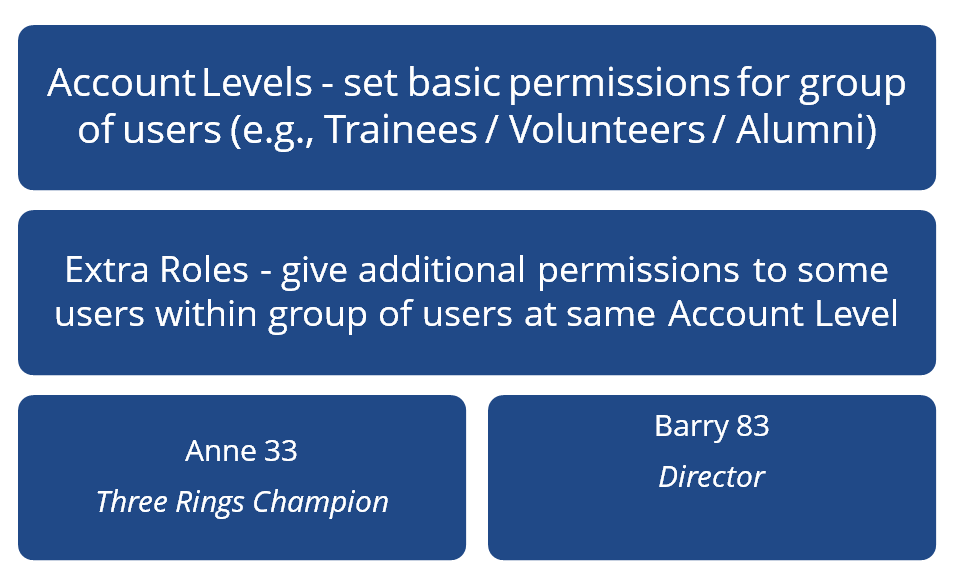
This is actually a much simpler structure. Organisations would be able to create one account Level for their Support Volunteers (who don’t need to see the Rota or the Directory, but could do with having access to the Wiki so they can see the list of maintenance tasks) and a different Level for their Listening Volunteers (who obviously need to be able to see the Rota!). Both types of account Level could have extra permissions granted through the Roles system, but organisations are spared the need to hamstring the permissions granted by the old catch-all ‘Everyone’ role, because the Levels system gives them closer control over which volunteers can see what.
What’s more, we’d allow organisations to change an individual’s Level just like they can change Roles. So if Charlie finished his training, he could be moved from Trainee Level to Volunteer Level, and automatically get more permissions (based on his organisation’s settings). Even better, if Charlie later moved on to volunteer for another organisation his account could be switched to an Alumni Level – he’d lose access to the Directory and the Rota (and any other data the organisation decided to keep away from him), but perhaps he’d still be able to see some information, such as ‘Alumni Level News’, as defined by his former colleagues: that way, he’d be able to keep in touch with developments back at his old organisation and, if there was ever an opportunity for him to help them out in some way, he’d hear about it through Three Rings without someone else needing to tell him specifically.
What that means is that our plans would make it possible for Three Rings to enable something we call ‘End to End Volunteering’.
End to End Volunteering
Right now, Three Rings is helping thousands of people to volunteer. It’s making it easier for organisations to manage their volunteers than at any other time in history. But we think it can do more.
Right now, Three Rings can only help manage volunteers who are fully trained and currently part of an organisation. Our vision for End to End Volunteering is that Levels could be used to let organisations track volunteers through Three Rings from the moment they apply to join until the time they move on to another organisation, and perhaps beyond.
Here’s a view of a volunteer’s path through an organisation, as it relates to Three Rings:
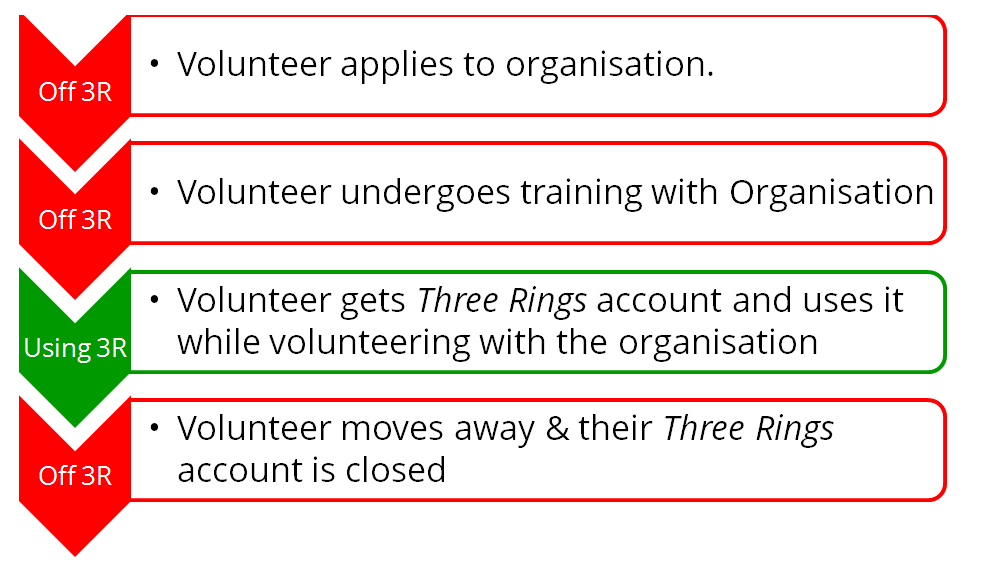
Of course, that diagram is a bit of a simplification – included in that single green box are no end of features that Three Rings provides to make things easier for the volunteer and the organisation. But, once Account Levels allow organisations finer control over what their users can see based on what kind of volunteer they are, End to End Volunteering creates a chart that looks more like this:
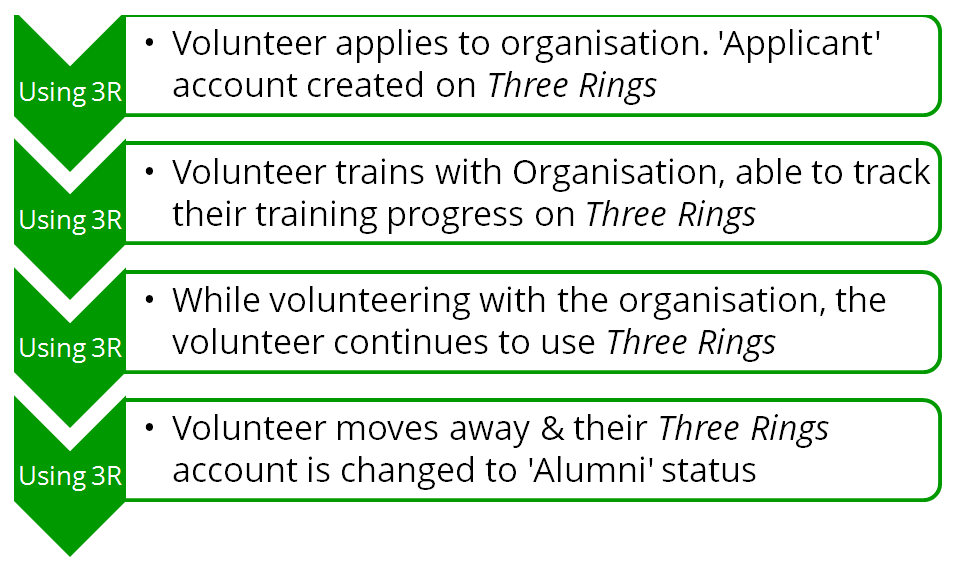
That’s a much more exciting prospect: because the permissions levels for a Trainee-Level account are much lower than those of a regular volunteer (at this organisation they just let a user see the dates & times of training sessions, and the contact details for the Training Team), a new volunteer can join the organisation with a Trainee-Level account that will track their progress through Training, and once their training is complete they can move up to a Volunteer-Level account, with more general access. When they leave they can take their personal details (together with their training record!) to a new organisation, where they can continue to useThree Rings. They’ll also be able to stay in touch with their old branch using the much-reduced permissions of an Alumni-Level account even as they gain new permissions and experiences with their new organisation.
That’s what we mean by End to End Volunteering: using Three Rings to make the whole volunteering experience easier for our users and organisations.
As far as we know, Three Rings is the oldest system of its type in the world, and the last ten years have seen some amazing developments, in terms of the number of people Three Rings is helping, the variety of different organisations on board and the technical capabilities of the system. We want to start the next decade of online rota management by continuing that improvement, and by making sure we offer as much help and support to volunteers as we can – whether they’re a new trainee, a current volunteer, or an ex-volunteer enjoying some well-earned rest.
There’ll be some exciting changes in our future, but we hope you can agree that our desire to forge closer relationships with our organisations, to streamline our own release cycle, and our re-affirmation of our ethical, non-profit business model puts us in a great position to lead all our users into the future.
